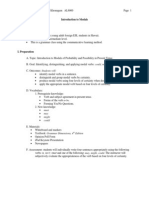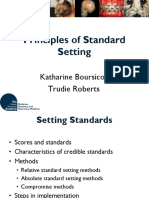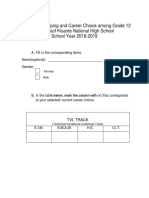Language Assessment and Proficiency Standards
Language Assessment and Proficiency Standards
Uploaded by
Chris KhonngamCopyright:
Available Formats
Language Assessment and Proficiency Standards
Language Assessment and Proficiency Standards
Uploaded by
Chris KhonngamCopyright
Available Formats
Share this document
Did you find this document useful?
Is this content inappropriate?
Copyright:
Available Formats
Language Assessment and Proficiency Standards
Language Assessment and Proficiency Standards
Uploaded by
Chris KhonngamCopyright:
Available Formats
Language Assessment and Proficiency Standards Chris Khonngam EDUC 6187 Language Assessment and Proficiency Standards I concur
with authors Kunan and Grabowski (2013) when they state that without
assessment, teaching would be incomplete (p. 304); and I would add that without an indicator of student achievement, learning is incomplete. Large-scale assessment and the standards that underpin them have a special place in assessment in that they set a bar for student achievement and thus can stimulate motivation. This is especially true for high-stakes exams such as the Test of English as a Foreign Language (TOEFL), which is used my many American institutions to determine English proficiency for university intake purposes (Llosa, 2011, pp. 206-7); and the Test of English for International Communication (TOEIC), which is used by many multi-lingual businesses (and some institutions in Asia) to determine English competency in the workplace (Ibid, p. 207-8). These exams establish a baseline standard of achievement for educational and workforce institutions that are highly valid and reliable (Kunan & Grabowski, 2013, pp. 311-12). However, as pointed out by Lorena Llosa (2011), the downside for instruction is less attention paid to classroom-based assessment which can be more authentic and meaningful (p. 368). Despite the inclusion of direct measures in large-scale tests for some tasks, such as reading and writing (Murray & Christison, 2011, p. 206), the majority consist of indirect measures such as multiple-choice, which are less authentic indicators of proficiency (Ibid, p. 200). Standardized tests are designed to measure competence in a specific target-language use (TLU) domain as opposed to general-use, which limits their validity (Kunan & Grabowski, 2013, p. 308). As a result of the limited TLU domain and use of indirect measures, standardized tests such as TOEFL and TOEIC may be unreliable indicators of real-life fluency. In addition, students may place too much reliance on exam-study courses rather than fluency-building classes. This can result in the unfortunate scenario of learners passing the standardized exams but
Language Assessment and Proficiency Standards Chris Khonngam EDUC 6187 failing to achieve real-world fluency. Therefore, students with proficiency in one register, such as the workplace, may be deficient in another register, such as in social situations. I believe this inhibits psychosocial identity integration, a process which can strengthen motivation to learn a second language (Masgoret & Gardner, 2003) and improve fluency by fostering willingness to communicate (MacIntyre, Baker, Clement, & Conrad, 2001). Lorena Llosa (2011) observes that speaking is an interactive medium that is collaboratively co-constructed (p. 203), a process that is difficult to measure using primarily indirect measures. A key factor in conversational English is the ability to negotiate meaning (Bell, 2009), a context that can only be observed where there are multiple actors. Vygotsky (1986) famously declared that all learning, but especially language, was a social activity. If the purpose of assessment is to provide a systematic indication of abilities with respect to what has been taught (Kunnan & Grabowski, 2013, p. 304), then it is questionable whether a social skill can be accurately measured in a non-social context. Large-scale proficiency tests have an important role in the field of Second Language Acquisition influencing the establishment and attainment of specific standards. However, they
may not be accurate indicators of real-world ability. This is not a fault of the test developers, but a misapplication of the exams usefulness by stakeholders, including students themselves. Evidence claims published by major test developers are usually quite clear regarding the consistency and applicability of their products (Kunnan & Grabowski, 2013, p. 311). Unfortunately, the popularity of the exams invites their misuse and application in contexts for which they were not originally intended. The high-stakes nature of standardized exams ensures they will continue to receive a disproportionate amount of attention, but the importance attributed to them needs to be mitigated by a clear appreciation of their inherent limitations.
Language Assessment and Proficiency Standards Chris Khonngam EDUC 6187 References Bell, N. (2009). A students guide to the MA TESOL. New York: Palgrave Macmillan. Kunnan, J. K. & Grabowski, K. (2013). Large-scale second language assessment. In CelceMurcia, M., Brinton, D. M., & Snow, M. A. (Eds.), Teaching English as a second or foreign language (304-319). Boston, MA: Heinle, Cengage Learning.
Llosa, L. (2011). Standards-based classroom assessments of English proficiency: A review of the issues, current developments, and future directions for research. Language Testing, 28(3), 367382. MacIntyre, P., Baker, S., Clement, R., & Conrad, S. (2001). Willingness to communicate, social support, and language-learning orientations of immersion students. Studies in Second Language Acquisition, 23, 369-388. Masgoret, A. M., & Gardner, R. C. (2003). Attitudes, Motivation, and Second Language Learning: A MetaAnalysis of Studies Conducted by Gardner and Associates. Language Learning, 53(1), 123. Murray, D. E., & Christison, M. (2011). What English language teachers need to know, Volume II: Facilitating learning. New York, NY: Routledge. Vygotsky, L. (1986). Thought and language. MIT Press.
You might also like
- DIAGNOSTIC IN ORG & - MGT With Answer KeyDocument7 pagesDIAGNOSTIC IN ORG & - MGT With Answer Keyfrances_peña_7100% (7)
- Test-Taking Strategy HughesDocument11 pagesTest-Taking Strategy Hughesapi-296486183No ratings yet
- Language Curriculum Design and ManagementDocument8 pagesLanguage Curriculum Design and ManagementHuỳnh ThạchNo ratings yet
- CATSS Vocabulary TestDocument13 pagesCATSS Vocabulary TestPeter0% (1)
- Chapter 1 - Assessment Concepts and IssuesDocument21 pagesChapter 1 - Assessment Concepts and IssuesRaita JuliahNo ratings yet
- Reflection Report - LTA - Bui Thu HienDocument33 pagesReflection Report - LTA - Bui Thu HienCrystal SkyNo ratings yet
- Lesson Plan - Used ToDocument29 pagesLesson Plan - Used ToChris Khonngam67% (3)
- Assessing Academic Literacy in a Multilingual Society: Transition and TransformationFrom EverandAssessing Academic Literacy in a Multilingual Society: Transition and TransformationNo ratings yet
- What Is A Language Test + Chapter 1 McNamaraDocument9 pagesWhat Is A Language Test + Chapter 1 McNamaraYamith J. Fandiño100% (5)
- Item Analysis of MCQDocument4 pagesItem Analysis of MCQBandya SahooNo ratings yet
- Assessing Vocabulary in The Language ClassroomDocument7 pagesAssessing Vocabulary in The Language ClassroomIsnaPurnamaNo ratings yet
- Extensive Listening in CLT in EFL ContextDocument9 pagesExtensive Listening in CLT in EFL ContextAbir BotesNo ratings yet
- Factors Influencing The Speaking Skills of Bachelor of Secondary Education Major in Mathematics StudentsDocument13 pagesFactors Influencing The Speaking Skills of Bachelor of Secondary Education Major in Mathematics StudentsPsychology and Education: A Multidisciplinary JournalNo ratings yet
- Roger HawkeyDocument33 pagesRoger HawkeyAna TheMonsterNo ratings yet
- Module ThreeDocument57 pagesModule ThreeЮлия КумичеваNo ratings yet
- Problems of Teaching English As A Foreign Language in YemenDocument13 pagesProblems of Teaching English As A Foreign Language in YemenSabriThabetNo ratings yet
- Language Assessment (TSL 3123) 6 Pismp Tesl 4Document9 pagesLanguage Assessment (TSL 3123) 6 Pismp Tesl 4Amirrul ZarithNo ratings yet
- Pdf-Final Vocabulary AssessmentDocument31 pagesPdf-Final Vocabulary Assessmentapi-456438584No ratings yet
- English Language Testing in PakistanDocument14 pagesEnglish Language Testing in PakistanZameer NawazNo ratings yet
- PPP Vs TBLDocument2 pagesPPP Vs TBLAndreas GavaliasNo ratings yet
- Integrating Language Skills To Efl Learners Through Poems and PoetryDocument9 pagesIntegrating Language Skills To Efl Learners Through Poems and PoetryDanang Dwi PradityaNo ratings yet
- English Anxiety Among College StudentsDocument3 pagesEnglish Anxiety Among College StudentsJake MaliNo ratings yet
- (All) A Study On Second - Year Students' Difficulties in Reading Esp Materials at Automobile Technology Department in Vietnam-Korea Technical CollegeDocument102 pages(All) A Study On Second - Year Students' Difficulties in Reading Esp Materials at Automobile Technology Department in Vietnam-Korea Technical CollegeTrần Thùy DươngNo ratings yet
- Teacher Training For In-Service EFL Teachers at A Thai UniversityDocument36 pagesTeacher Training For In-Service EFL Teachers at A Thai UniversityOo MayNo ratings yet
- Cohesive Features in Argumentative Writing Produced by Chinese UndergraduatesDocument14 pagesCohesive Features in Argumentative Writing Produced by Chinese UndergraduateserikaNo ratings yet
- Computer-Assisted Pronunciation Teaching (CAPT) To Overcome Pronunciation Difficulties Among EFL BeginnersDocument9 pagesComputer-Assisted Pronunciation Teaching (CAPT) To Overcome Pronunciation Difficulties Among EFL BeginnersInternational Journal of Innovative Science and Research TechnologyNo ratings yet
- The International Corpus of Learner EnglishDocument10 pagesThe International Corpus of Learner EnglishAzam BilalNo ratings yet
- The Effects of Texting On Literacy: Modern Scourge or Opportunity?Document8 pagesThe Effects of Texting On Literacy: Modern Scourge or Opportunity?Helix NebulaNo ratings yet
- L1 in The English ClassroomDocument8 pagesL1 in The English ClassroomerzsebetkacsoNo ratings yet
- Is PPP Dead?: Jeremy HarmerDocument9 pagesIs PPP Dead?: Jeremy HarmerSherrey WalterNo ratings yet
- Differences Between Syllabus Design and MethodologyDocument1 pageDifferences Between Syllabus Design and MethodologyEnamul Chowdhury100% (1)
- Anglais Mock Probatoire Acdti 2024Document5 pagesAnglais Mock Probatoire Acdti 2024Jean MbargaNo ratings yet
- Social Factors and SLA - PpsDocument36 pagesSocial Factors and SLA - PpsDiego J Arcos100% (1)
- A Review of Washback and Its Pedagogical Implications PDFDocument7 pagesA Review of Washback and Its Pedagogical Implications PDFĐỗ Quỳnh TrangNo ratings yet
- DeKeyser 2005 Language LearningDocument25 pagesDeKeyser 2005 Language LearningSharonQuek-TayNo ratings yet
- Phương Pháp Nghiên C U KHDocument11 pagesPhương Pháp Nghiên C U KHTrang ThuNo ratings yet
- Delta Module Three Principal Examiners Report June 2009Document20 pagesDelta Module Three Principal Examiners Report June 2009TonyNo ratings yet
- The Use of Language Learning AppsDocument11 pagesThe Use of Language Learning AppsHind HindranceNo ratings yet
- i01-2CC83d01 - Intercultural Communication in English Language Teacher EducationDocument9 pagesi01-2CC83d01 - Intercultural Communication in English Language Teacher EducationMuhammad Iwan MunandarNo ratings yet
- Module 2 - Techniques For TestingDocument25 pagesModule 2 - Techniques For TestinglearnerivanNo ratings yet
- Al Zayid 2012 The Role of Motivation in The L2 Acquisition of English by Saudi Students - A Dynamic Perspective (THESIS)Document112 pagesAl Zayid 2012 The Role of Motivation in The L2 Acquisition of English by Saudi Students - A Dynamic Perspective (THESIS)hoorieNo ratings yet
- Needs Analysis of The English Language Secondary Hotel Students in Jordan1Document18 pagesNeeds Analysis of The English Language Secondary Hotel Students in Jordan1anon_241479276No ratings yet
- Mark Jones Teacher CurriculumDocument2 pagesMark Jones Teacher CurriculumSonsaku HakufuNo ratings yet
- Language Curriculum Design - PrinciplesDocument31 pagesLanguage Curriculum Design - PrinciplesPerry Amatorio Delos Reyes Jr.100% (1)
- Intensive and Extensive ListeningDocument18 pagesIntensive and Extensive ListeningMaria Octa ElsavanaNo ratings yet
- Nicholas Rion, Karwan Kakabra Kakamad, Abdulfatah Hasan Fatah Soran University, Faculty of Arts, Psychology Department, IraqDocument9 pagesNicholas Rion, Karwan Kakabra Kakamad, Abdulfatah Hasan Fatah Soran University, Faculty of Arts, Psychology Department, IraqSedigheh ShakibNo ratings yet
- 08 Teaching GrammarDocument23 pages08 Teaching GrammarGab GapasNo ratings yet
- Plagiarism A Guide For Delta Module Three PDFDocument12 pagesPlagiarism A Guide For Delta Module Three PDFSamina ShamimNo ratings yet
- The - Assessment of - Speaking - Skills at - The ErtiaryDocument18 pagesThe - Assessment of - Speaking - Skills at - The Ertiaryaira rafniNo ratings yet
- Waluyo & Bakoko (2021)Document12 pagesWaluyo & Bakoko (2021)Mai PinkyNo ratings yet
- Scmitt VLS Taxonomy PDFDocument7 pagesScmitt VLS Taxonomy PDFEvelin ĐilvesiNo ratings yet
- Testing and Assessing ListeningDocument34 pagesTesting and Assessing ListeningHammad AlbariNo ratings yet
- Review of McNamara - Language TestingDocument3 pagesReview of McNamara - Language TestingPaul Hughes100% (1)
- On Some Aspects of Internet Slang: Liana BarseghyanDocument13 pagesOn Some Aspects of Internet Slang: Liana BarseghyanAnzhela KozakNo ratings yet
- Teacher TalkDocument6 pagesTeacher TalkGloria GinevraNo ratings yet
- 490354the Oral Error Correction Techniques Used by Libyan Secondary School Teachers of English Muhsen Abobaker A. Ali ADocument315 pages490354the Oral Error Correction Techniques Used by Libyan Secondary School Teachers of English Muhsen Abobaker A. Ali ALouis WilliamNo ratings yet
- Testing Speaking Skills Term PaperDocument10 pagesTesting Speaking Skills Term PaperRio NoaZoroNo ratings yet
- Using L1 in Esl Class by SchweersDocument5 pagesUsing L1 in Esl Class by SchweersRidzwan Rulam Ahmad100% (1)
- Anxiety in EFL Classrooms: Causes and Consequences: Meihua LiuDocument20 pagesAnxiety in EFL Classrooms: Causes and Consequences: Meihua LiuEmpressMay ThetNo ratings yet
- Mind Matters in SLAFrom EverandMind Matters in SLAClare WrightNo ratings yet
- Analysis of a Medical Research Corpus: A Prelude for Learners, Teachers, Readers and BeyondFrom EverandAnalysis of a Medical Research Corpus: A Prelude for Learners, Teachers, Readers and BeyondNo ratings yet
- Adult Minority Language Learning: Motivation, Identity and Target VarietyFrom EverandAdult Minority Language Learning: Motivation, Identity and Target VarietyNo ratings yet
- Asking WorksheetDocument1 pageAsking WorksheetChris KhonngamNo ratings yet
- News PollDocument1 pageNews PollChris KhonngamNo ratings yet
- The Lava Is ComingDocument1 pageThe Lava Is ComingChris KhonngamNo ratings yet
- Opinion Poll: Is May Might Could Must Isn'tDocument1 pageOpinion Poll: Is May Might Could Must Isn'tChris KhonngamNo ratings yet
- Mystery Person WorksheetDocument2 pagesMystery Person WorksheetChris KhonngamNo ratings yet
- At-On-In Used in Time and DatesDocument1 pageAt-On-In Used in Time and DatesChris KhonngamNo ratings yet
- Celebrity InterviewDocument2 pagesCelebrity InterviewChris KhonngamNo ratings yet
- Sales PresentationDocument1 pageSales PresentationChris KhonngamNo ratings yet
- What Is Your Favorite Holiday?: in American English, Holiday Means FestivalDocument1 pageWhat Is Your Favorite Holiday?: in American English, Holiday Means FestivalChris KhonngamNo ratings yet
- How Often Do You ?Document1 pageHow Often Do You ?Chris KhonngamNo ratings yet
- Job HuntDocument1 pageJob HuntChris KhonngamNo ratings yet
- My Way or Thai WayDocument3 pagesMy Way or Thai WayChris KhonngamNo ratings yet
- Articles FlowchartDocument1 pageArticles FlowchartChris KhonngamNo ratings yet
- Modified IRF Use in Formative AssessmentDocument3 pagesModified IRF Use in Formative AssessmentChris KhonngamNo ratings yet
- Introduction To ModalsDocument4 pagesIntroduction To ModalsChris KhonngamNo ratings yet
- Prior Knowledge Effects in SLADocument3 pagesPrior Knowledge Effects in SLAChris KhonngamNo ratings yet
- Story 3 َّ نلا َّ مَّ م َّ ةَّ َّ و َّ جلا َّ رَّ دا َّ ة: The Ant and the grasshopperDocument2 pagesStory 3 َّ نلا َّ مَّ م َّ ةَّ َّ و َّ جلا َّ رَّ دا َّ ة: The Ant and the grasshopperRalucaMihaNo ratings yet
- Persuasive Speech UnitDocument63 pagesPersuasive Speech UnitNoel Cagigas Felongco0% (1)
- P H I L C S T: Philippine College of Science and TechnologyDocument11 pagesP H I L C S T: Philippine College of Science and Technologyraul gironellaNo ratings yet
- 51 Principles of Standard SettingDocument32 pages51 Principles of Standard Settings_fawzyhafezNo ratings yet
- Writing Activity Guide: General ObjectiveDocument13 pagesWriting Activity Guide: General ObjectivePatricia MendezNo ratings yet
- Question Format of Civil EngineeringDocument2 pagesQuestion Format of Civil EngineeringTun Lin NaingNo ratings yet
- Module in Principles & Theories123Document36 pagesModule in Principles & Theories123Lealyn Ordinario100% (1)
- I. Preparation For Reading: Splat The Cat and The Pumpkin-Picking Plan Guided Reading Plan Standard(s)Document5 pagesI. Preparation For Reading: Splat The Cat and The Pumpkin-Picking Plan Guided Reading Plan Standard(s)api-302553488No ratings yet
- Slavery in The ChocolateIndustry ChocolateIndustryDocument3 pagesSlavery in The ChocolateIndustry ChocolateIndustryaali1219No ratings yet
- Lesson 1 (Week 3)Document2 pagesLesson 1 (Week 3)BrenNan ChannelNo ratings yet
- Protectia SocialaDocument15 pagesProtectia SocialaBrasoveanuRobertNo ratings yet
- Lesson Plan in Science and Health Pre-SchoolDocument3 pagesLesson Plan in Science and Health Pre-SchoolRickson Topinio DaytoNo ratings yet
- ENG 101 Essay 1 Chopin The Story of An Hour Final DraftDocument4 pagesENG 101 Essay 1 Chopin The Story of An Hour Final DraftCristie Wasley GreerNo ratings yet
- DIKSHA - Strategy - Approach - Paper PDFDocument38 pagesDIKSHA - Strategy - Approach - Paper PDFSrinath SaravananNo ratings yet
- Reading As A Language ProcessDocument23 pagesReading As A Language ProcessLiency AnsinoNo ratings yet
- Sample Transcript With BadgesDocument3 pagesSample Transcript With BadgesSam Pacefalm0% (1)
- Note of Thank You For InternshipDocument1 pageNote of Thank You For InternshipAbdulBasitKhanSadozaiNo ratings yet
- Emma Jane AustenDocument5 pagesEmma Jane AustenShinSungYoungNo ratings yet
- Greece - Final1Document6 pagesGreece - Final1English ItalianNo ratings yet
- Tvet Qar PDFDocument258 pagesTvet Qar PDFAppieNo ratings yet
- Parenting Tips From MontessoriDocument52 pagesParenting Tips From Montessorintmurphy100% (4)
- Code-Switching in Filipino NewDocument95 pagesCode-Switching in Filipino NewraekaraquelNo ratings yet
- Overcoming Cultural and Language BarriersDocument3 pagesOvercoming Cultural and Language BarriersAmizhdhan Senthil VelanNo ratings yet
- DLP MT Y4 W1Document2 pagesDLP MT Y4 W1Kala Devy100% (1)
- BRM Research PaperDocument12 pagesBRM Research PaperNandita Goswami33% (3)
- The Art of Flourishing by Jeffrey B. Rubin, PH.D - ExcerptDocument35 pagesThe Art of Flourishing by Jeffrey B. Rubin, PH.D - ExcerptCrown Publishing Group60% (5)
- NIV Stewardship Study Bible, ExcerptDocument22 pagesNIV Stewardship Study Bible, ExcerptZondervan75% (4)
- Gender Stereotyping and Career Choice Among Grade 12 Studentsof Kisante National High School School Year 2018-2019Document2 pagesGender Stereotyping and Career Choice Among Grade 12 Studentsof Kisante National High School School Year 2018-2019Melchor BalolongNo ratings yet
- SHS Orientation ProgramDocument4 pagesSHS Orientation ProgramJefferson Aguilar100% (1)










































































































